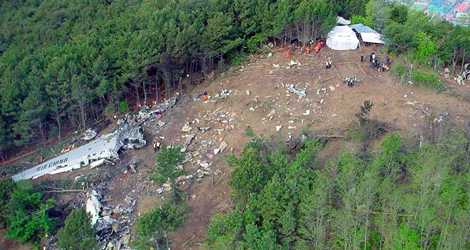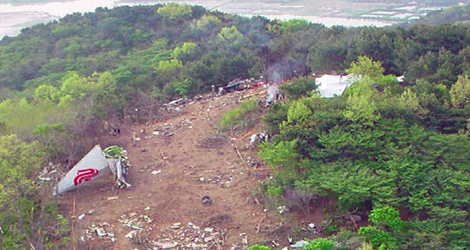On April 15, 2002, about 11:21:17 (02:21:17 UTC), Air China flight CCA129, a Boeing 767-200ER, Chinese registration B2552, operated by Air China, en route from Beijing, China to Busan, Korea, crashed on Mt. Dotdae, located 4.6 km north of runway 18R threshold at Gimhae airport (Busan) , at an elevation of 204 meters Mean Sea Level (MSL). Air China flight CCA129 departed from Beijing airport, China, with one captain, two copilots, eight flight attendants and 155 passengers on board, and was conducting the circling approach to runway 18R at Gimhae airport, after it received its landing clearance. Of the 166 persons on board Air China flight CCA129 , 37 persons including the captain and two flight attendants survived, while 129 occupants including two copilots were killed.
At 11:20:17, during the circling, the captain of Air China AAC129 said, “I have control “(我來飛)
The aircraft was completely destroyed by impact forces and a postcrash fire. Of the 166 persons on board, 37 persons including the captain and two flight attendants survived, while the remaining 129 occupants including two copilots were killed.
At 11:21:09, the captain of Air China flight CCA129 asked, “Have the runway in sight?(看到跑道了嗎),” … at 11:21:10, the first officer replied, “No, I cannot see out (沒有, 看不着).
Causes :
- The flight crew of Air China flight CCA129 performed the circling approach, not being aware of the weather minima of wide-body aircraft (B767-200) for landing, and in the approach briefing, did not include the missed approach, etc., among the items specified in Air China’s operations and training manuals.
- The flight crew exercised poor crew resource management and lost situational awareness during the circling approach to runway 18R, which led them to fly outside of the circling approach area, delaying the base turn, contrary to the captain’s intention to make a timely base turn.
- The flight crew of Air China flight CCA129 did not execute a missed approach when they lost sight of the runway during the circling approach to runway 18R, which led them to strike high terrain (mountain) near the airport.
- When the first officer advised the captain to execute a missed approach about 5 seconds before impact, the captain did not react, nor did the first officer initiate the missed approach himself.

Air China flight CCA129 – Boeing B767-200ER (B-2552)
Findings Related to Risk
- The flight crew’s training for the circling approach was conducted with the simulator only for Beijing airport, and they had never been trained for the circling approach to Gimhae airport’s runway 18R.
- The crew resource management (CRM) training of Air China was insufficient for the three flight crew complement.
- Air China did not perform the improving action for Service Bulletin (SB) 767-34-0067 (May 31, 1989), which was issued by the Boeing Company for the reinforcement of the GPWS functions.
- Air China provided one set of Jeppesen manuals to the flight crew, which the captain was using during the instrument approach, making it difficult for the other flight crewmembers to crosscheck the information in the manuals.
- Instrument approach chart used by the flight crew of flight 129 did not depict the high terrain north of the airport.
- During the circling approach of Air China flight CCA129, the flight crew did not use standard callouts defined by Air China.
- Flight 129 was flown between 150 and 160 kt on the downwind leg, which exceeded the maximum speed of 140 kt of Gimhae airport’s circling approach category “C,” and the width of the downwind leg was narrower than normal, for which corrective actions were inappropriate.
- The second officer, tasked with handling radio communications, did not reply correctly to controllers’instructions a number of times, however, the captain and first officer did not correct the second officer’s inappropriate replies.
- When the tower controllers lost visual contact with the flight 129 aircraft on the downwind and base legs, they tried to find the flight 129 aircraft visually, however, they did not use the tower BRITE, which is an aid to complement visual observations.
- The flight crew did not reply appropriately to the local controller’s question when the controller asked them the possibility of landing, because the local controller did not have the flight 129 aircraft in sight after issuing the landing clearance.
- The approach controller felt that the flight 129 aircraft was flying on a longer pattern than normal, so he asked the local controllers via intercom, “Does it seem go around?” however, the local controllers stated that they did not hear this question.
- The local controller asked a question to the flight crew to confirm the position of the aircraft, however, the local controller did not issue any direct warning or advice based on his own subjective awareness of the situation.
- “The Korean Standard Air Traffic Control Procedures”and “Gimhae Base Local Procedures”did not specify radar monitoring of the aircraft on a circling approach by means of the BRITE and MSAW systems.
- The MSAW system installed in Gimhae tower at the time of the accident was designed only with the function of visual warning, which was not consistent with the ICAO recommendation to include an aural warning also. Thus, the low altitude (LA) warning would not have been noticed in a timely manner, unless the controller monitored the BRITE closely.
- The MSAW activation area was programmed in the vicinity north of the circling approach area of Gimhae airport, which was set to be higher than the altitude of the circling approach pattern, and the MSAW would be activated in the case of a normal base turn in close proximity to the MSAW activation area within the circling approach area due to its predictive warning function.
- When the aircraft disappeared from radar, and radio communication was lost between the tower and the aircraft, the tower controllers did not notify the search and rescue department in a timely manner.
- The measuring equipment of runway visual range (RVR) of Gimhae airport runway (18R/36L) had been out of order for a considerable time period, thus it had not been operated appropriately for the purpose of category II runway-use.
Download Report


0 Comments